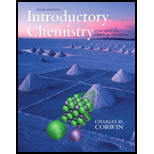
Concept explainers
(a)
Interpretation:
The simplified ionization equation of the pure water is to be stated.
Concept introduction:
Pure water is not a very good conductor of electricity due to the presence of a very small number of ions that are responsible for the flow of electricity. This happens very rarely that two water molecules collide with the appropriate amount of energy to give back hydronium ion
(b)
Interpretation:
The ionization constant equation of the pure water is to be stated.
Concept introduction:
Pure water is not a very good conductor of electricity due to the presence of a very small number of ions that are responsible for the flow of electricity. This happens very rarely that two water molecules collide with the appropriate amount of energy to give back hydronium ion
(c)
Interpretation:
The ionization constant of the pure water at
Concept introduction:
Pure water is not a very good conductor of electricity due to the presence of a very small number of ions that are responsible for the flow of electricity. This happens very rarely that two water molecules collide with the appropriate amount of energy to give back hydronium ion
Want to see the full answer?
Check out a sample textbook solution
Chapter 14 Solutions
Introductory Chemistry: Concepts And Critical Thinking, Books A La Carte Edition (8th Edition)
- What is the freezing point of vinegar, which is an aqueous solution of 5.00% acetic acid, HC2H3O2, by mass (d=1.006g/cm3)?arrow_forwardWrite two BrnstedLowry acid-base reactions and show how they represent proton-transfer reactions.arrow_forwardComplete and balance the given equation. Identify the acid, base, conjugate acid, and base showing the reaction of the weak acid/base with water.arrow_forward
- A student is given a concentrated solution that is supposed to contain vinegar, a weak acid. Which of the following experimental tests would best support the claim that the solution is a weak acid rather than a strong acid?arrow_forwardDefine the term Percent Ionization?arrow_forwardThe pH of an aqueous solution of 0.458 M pyridine (a weak base with the formula C5H5N) is ?arrow_forward
- Chemistry: Matter and ChangeChemistryISBN:9780078746376Author:Dinah Zike, Laurel Dingrando, Nicholas Hainen, Cheryl WistromPublisher:Glencoe/McGraw-Hill School Pub Co
 Introductory Chemistry: An Active Learning Approa...ChemistryISBN:9781305079250Author:Mark S. Cracolice, Ed PetersPublisher:Cengage Learning
Introductory Chemistry: An Active Learning Approa...ChemistryISBN:9781305079250Author:Mark S. Cracolice, Ed PetersPublisher:Cengage Learning Chemistry: Principles and ReactionsChemistryISBN:9781305079373Author:William L. Masterton, Cecile N. HurleyPublisher:Cengage Learning
Chemistry: Principles and ReactionsChemistryISBN:9781305079373Author:William L. Masterton, Cecile N. HurleyPublisher:Cengage Learning  Principles of Modern ChemistryChemistryISBN:9781305079113Author:David W. Oxtoby, H. Pat Gillis, Laurie J. ButlerPublisher:Cengage Learning
Principles of Modern ChemistryChemistryISBN:9781305079113Author:David W. Oxtoby, H. Pat Gillis, Laurie J. ButlerPublisher:Cengage Learning Chemistry: Principles and PracticeChemistryISBN:9780534420123Author:Daniel L. Reger, Scott R. Goode, David W. Ball, Edward MercerPublisher:Cengage Learning
Chemistry: Principles and PracticeChemistryISBN:9780534420123Author:Daniel L. Reger, Scott R. Goode, David W. Ball, Edward MercerPublisher:Cengage Learning Chemistry for Today: General, Organic, and Bioche...ChemistryISBN:9781305960060Author:Spencer L. Seager, Michael R. Slabaugh, Maren S. HansenPublisher:Cengage Learning
Chemistry for Today: General, Organic, and Bioche...ChemistryISBN:9781305960060Author:Spencer L. Seager, Michael R. Slabaugh, Maren S. HansenPublisher:Cengage Learning





